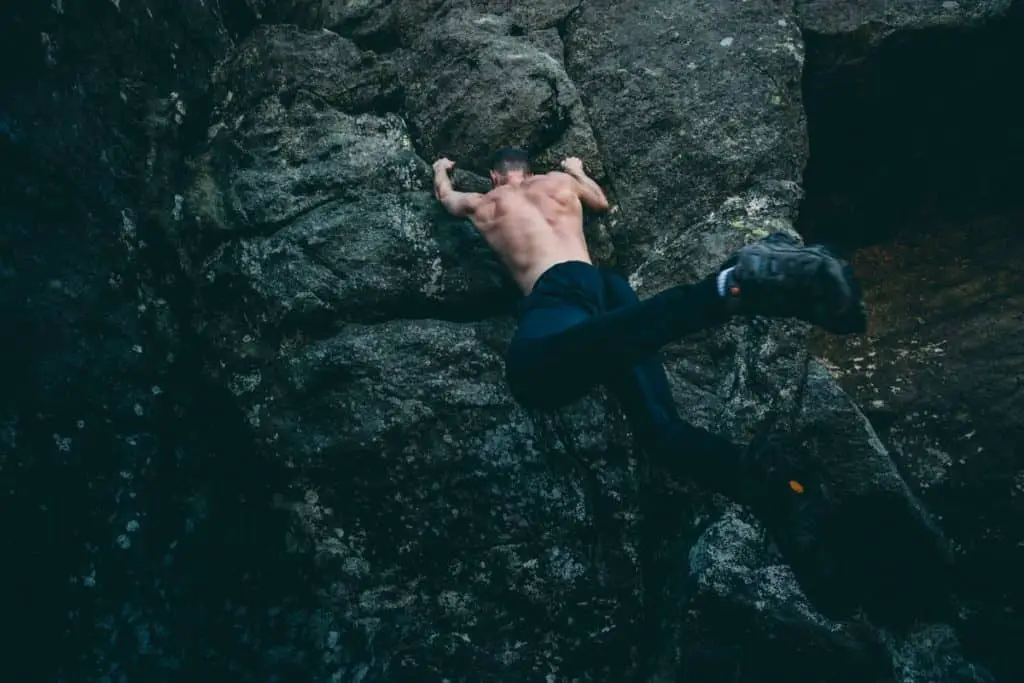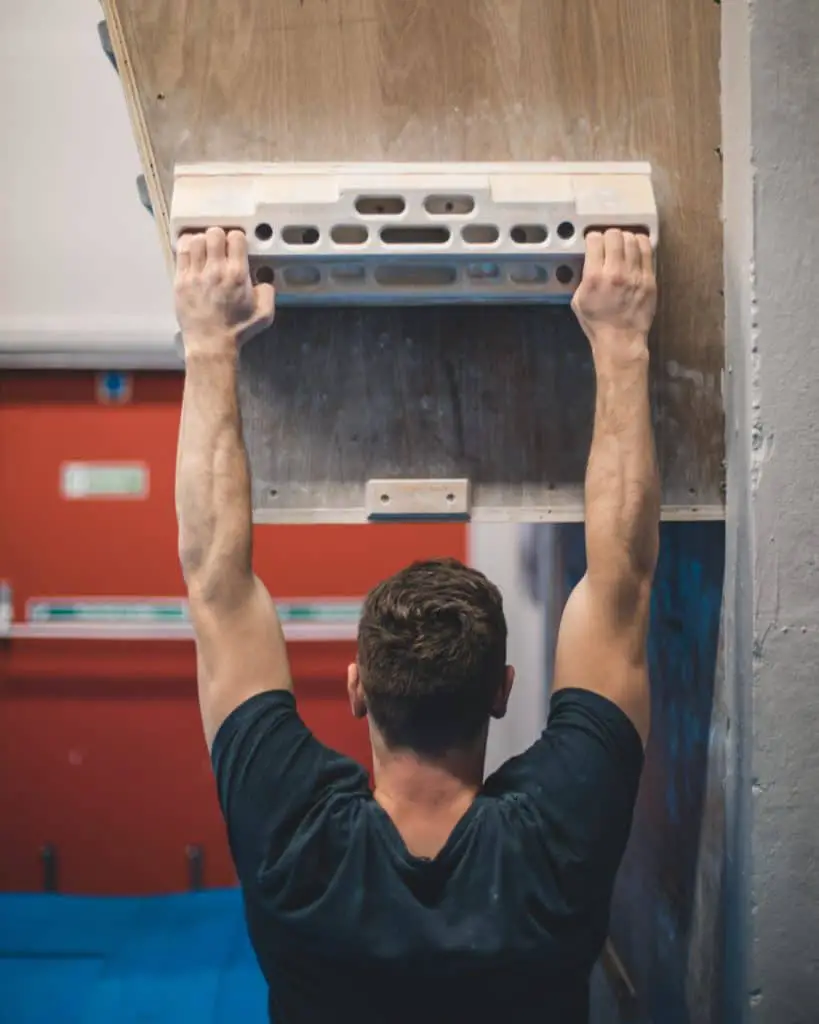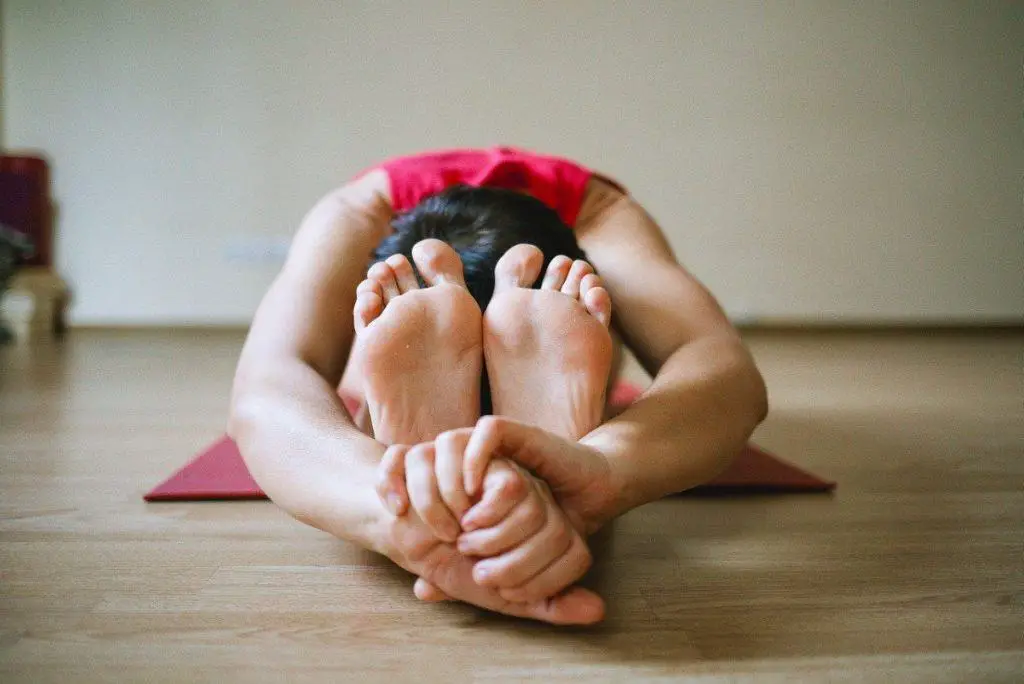
Have you ever wondered how climbers like Alex Honnold can ascend a 3000 foot wall without falling in 4 hours… while some people lose their grip on a 15 foot bouldering wall because their forearms are too tired after only training in the gym for 30 minutes? What determines this seemingly superhuman ability to cover terrain vertically? The answer is muscular endurance (ME). Also called strength endurance, muscular endurance training is of supreme significance to every athlete involved in repetitive movement sports that lasts more than thirty minutes.
So how can you improve muscular endurance for rock climbing? The main areas of focus when trying to improve muscular endurance for rock climbing are the forearms/fingers, the core, the biceps and the lats (the main back muscle). To improve muscular endurance in the forearms and fingers you should hangboard regularly, increasing the load overtime so you can increase the endurance of your muscles. There are many core workouts out there, a few are planks, crunches, sit ups and leg raises, but these must be done slowly. Slow bicep curls with a heavy weight will increase muscular endurance of the biceps, and slow pull ups will help the lats. Several studies have also shown that yoga can help improve muscular endurance in all areas of the body which is a great bonus for climbing as they go hand in hand.
Read on for more information that will help you improve your muscular endurance for climbing while also helping you learn more about your own body.
Page Jumps
- Why Does Rock Climbing Require Muscular Endurance?
- In What Areas of the Body Do Rock Climbers Need Muscular Endurance?
- What Types of Climbs Require The Most Muscular Endurance?
- How Can Climbers Improve Muscular Endurance?
- Ways to Increase Core Strength Endurance for Climbing
- How Anaerobic Endurance Relates to Muscular Endurance
- Ways to Improve Muscular Endurance While In the Climbing Gym, At Home and in a Normal Gym
- Using the Right Climbing Technique Will Mean You Won’t Need To Use Your Muscles as Much
Why Does Rock Climbing Require Muscular Endurance?
Rock climbers need to have the muscular endurance necessary to finish a rock-climbing route. Without muscular endurance, it is unlikely that a rock climber will be able to finish even an amateur route. Two factors that are vital for a successful climbing session are strength and power. Shoulder and arm strength as well as good muscular endurance benefit rock climbing. A rock climber’s success can be explained by:
- maximum grip strength
- forearm endurance
- forearm strength
- shoulder strength
- shoulder endurance
High level rock climbers are not unusually strong. It is their strength to body mass ratio that’s high. Low body mass and low body fat percentages are beneficial in the performance of rock climbing, coupled with a lot of strength for their weight. However, these are not prerequisites to become a rock climber. Training variables such as shoulder extensions, knee flexion, knee extension, endurance, and grip strength are what matters in rock climbing.
Adam Ondra is the perfect example of a high level climber with a strength to body mass ratio that’s perfect for climbing.
In What Areas of the Body Do Rock Climbers Need Muscular Endurance?
It seems like rock climbing endurance draws on every type of movement that the physical human body can achieve. Rock climbing requires endurance, flexibility, fitness, and strength. While strong shoulders, arms, and fingers are necessary for pulling on handholds, it is also crucial to have efficient, proper footwork for climbing competency. Rock climbers need muscular endurance in the following areas:
- fingers/forearms
- toes
- hands
- shoulders/biceps
- lats/back
- calves
- forearms
- core
- thighs
- ankles
- knees
What Types of Climbs Require The Most Muscular Endurance?
One of the most physically intense activities, climbing uses your own strength to ascend up a wall and works your body in its entirety. No matter whether you are hitting the crag or the local gym, every move up and down those rocks will require your entire body’s muscles to get into overdrive.
- Slab climbing will require smoother movement over each rock rather than jerky, long moves and will require core muscles to work hard.
- Vertical faces will tend to use your forearm and your leg muscles more than any other muscle in your body.
- Overhanging walls will require finger strength and upper torso strength as you haul yourself up at an upward, overhanging angle. Overhang and roof climbing rely greatly on muscular endurance of the core.
How Can Climbers Improve Muscular Endurance?
There are more than a few ways climbers can improve muscular endurance. Here are the 4:
Use a Hangboard
Climbers can improve muscular endurance by using a hangboard for finger strength and endurance as well as forearm strength. Perhaps the best tool for developing strength in the fingers for rock climbing is with the hangboard. This one-stop training device can be used for all movements involved in climbing.
Use a hangboard that has two or three hold sizes. The one you get needs to be the one that feels like it actually fits. You won’t find a better tool to help you improve your finger strength than a hangboard but remember that a good warm up is essential before you begin your workout.
I’ve trained on a lot of hangboards in my time, and I know a few people that have them set up in their own house. Check out my recommendations if you’re thinking about setting up a hangboard area in your own home.

Stay Hydrated
If you don’t drink enough water, think about installing and using a free water drinking app on your smartphone. Drinking water regularly helps improve muscular endurance and is vital for good health. Make water a part of your endurance workout whether you are starting out after a long sedentary period or you are a regular climbing enthusiast.
Stay hydrated during your strength-building routine and you will see a difference in your endurance. In short, a hydrated body can perform longer. You can end up lethargic if you drink too little for your weight. Heavier athletes need higher water amounts. Those who perspire at a higher rate will need to drink more water. You won’t go very far if your body is losing more water through sweating than it is taking in.
Stretching and Yoga
Stretching and yoga tones muscles throughout your body and many studies have shown that it helps muscular endurance throughout the body. Typically, weight training exercises flex and isolate one group of muscles at a time. In contrast, yoga and stretching increase the endurance of your muscles because yoga requires you to hold a given pose or a given stretch for a time period and repeat it throughout the yoga workout several times.

Climbing Intervals
You can improve muscular endurance by performing climbing intervals and pull-up intervals. Climbing intervals is the first and most specific exercise for training pull-muscle and forearm endurance. It involves interval-climbing on a moderate to difficult climb or boulder problem. Ideally, the route would be laborious and steep. However, the route shouldn’t be too difficult technically that you would be unable to climb a few laps completely. The protocol for training is to alternating climbing rests and climbing burn intervals.
This is not unlike the interval training that runners do. The resting phase needs to be proportionate to the length of the climb phase. Thus, if your climb phase has to do with sending a ten-move boulder problem which takes about sixty seconds, you will want to rest thirty seconds between burns. Longer climb phases such as moving around your home wall, steep sport climbing, or lapping for a few minutes should be followed by a rest of similar lengths.
Pull-up Intervals is a highly effective exercise for building endurance in your upper arm and the larger muscles in your back. Your goal is to complete 20 one-minute pull-up intervals which are composed of a rest period and a set number of pull-ups taking one minute, exactly. Use a timer with a second hand or a clock so you can stay on the exact same schedule of training.
Begin the stopwatch, mount the fingerboard or pull-up bard, and crank out five pull-ups. Dismount and rest for the rest of the one-minute interval. Next, begin your next pull-up set of five. Once you complete the five pull-ups, rest for the remainder of the minute. Continue doing these repetitions of five pull-ups and one minute rests in between for a total of twenty minutes. If you are unable to make it to the ten-minute mark, at least, reduce the number of pull-ups to just three. You can also increase the number of pull-ups if you find the full twenty-minute routine feeling rather casual.
Ways to Increase Core Strength Endurance for Climbing
Strengthening all your other muscles without strengthening your core muscles is like putting the engine of an economy car into the chassis of a sports car. Without a solidified core, rock climbers risk injury and their core won’t be able to support them up the wall. Here are some exercises that strengthen your core muscles:
- Push-Ups. Traditional push-ups strengthen your upper body and core muscles as you try and keep your body off the floor as much as you can. This is a fantastic exercise that you can do anywhere. New variations also work to emphasize your core muscles and relieve the monotonous routine of doing fifty push-ups a day.
- Landmine Press. This core exercise also works your arms and shoulders. Use this exercise as much as you can while kneeling, if your goal is to work your core. Take a landmine or a barbell and position it by the wall. Grab the end with both hands, kneel and place it right below your chin. Lift repeatedly up and down. While the barbell is down, keep your elbows close to your body. Keep your upper torso as still as you can.
- Planking. One of the best-known core exercises, planking involves lifting your hips off the floor, getting on your toes and elbows, and keeping a straight line between your heels and head. This exercise benefits you better when your partner ensures you hold the posture properly.
- Leg Raises. Lie down on the floor on your back with your hands by your side. Lift both legs slightly off the floor and then raise both legs towards you, then release back down without touching then floor. Do this 10 times.
- Sit ups. Lie down on the floor on your back. Bring your feet around 10cm away from your bum. Sit up to your knees and back without touching the floor with your head. Do this 10 times.
- Boat Crunches. Get into a boat position – sitting with your feet and back off the ground. Push your head and legs away from each other and pull yourself back in with your core. Do this 20 times.
How Anaerobic Endurance Relates to Muscular Endurance
You know when you see someone on an extremely steep, high-graded overhang and they’re just bossing the whole route without a breather? That’s when you know they have high-level anaerobic endurance.
Rock climbers usually refer to anaerobic endurance in the pulling muscles (e.g. biceps and lats) and forearms. Generally, they don’t mean the aerobic endurance necessary for a full day of climbing or a long-distance run.
Think of anaerobic endurance as very high muscle endurance necessary to continuously climb a demanding sequence without taking a breather. Some climbers also call this power endurance.
When climbing, lactic acid and an obvious muscle pump development (usually in the biceps and forearms) are indications that you’ve hit the anaerobic endurance threshold.
To improve anaerobic endurance, you need to train correctly and often. High intensity, sustained muscular exercise and good diet can increase the threshold of your anaerobic endurance limit. To reduce lactic acid you need to drink lots of water, breathe properly, warm up before you exercise, rest up to a minute long between climbs, and increase your magnesium levels.
If you’re thinking of training like this then be prepared for a physically and mentally challenging process. But if you would like to improve your anaerobic threshold, climb higher grades, and reduce the amount of lactic acid you get when climbing, then this it’s what you need to do.
Ways to Improve Muscular Endurance While In the Climbing Gym, At Home and in a Normal Gym
In a Climbing Gym
Increase your rock climbing endurance at the climbing gym by doing pull-ups frequently. Pull-ups work the back, shoulders, and arms.
Race the clock by doing speed climbing. This helps improve your endurance of climbing and teaches your body to become more efficient. Find an easy grade climb that you’ve done a few times so you have the muscle memory down. Climb is as fast as you can. Either that or find a speed climbing wall.
Try some dead hangs, also known as an “un-exercise.” This helps your body build endurance for hanging. Climbing gyms usually have hangboards and other finger strengthening equipment that you should use. Dead hangs and brachial hangs can also heal shoulder injuries. To read more about this click here.
Most climbing gyms will have a circuit board and this is one of the best ways to improve your muscular endurance. Circuit boards will usually have 4 or 5 different grades on there. The best thing I can advise is for you to climb until you just feel yourself tiring, but not enough so that you feel too pumped. Have a minute or two rest and then repeat. We don’t want to over-train the forearms here.
At Home
Grab a large bucket and fill it with 30lbs of rice. Work your forearm flexors used for climbing and your extensors by putting both hands into the bucket and squeezing the rice. This helps prevent wrist injuries, forearm tightness, and tendonitis. Do variations by scooping the rice and extending your fingers. Other home exercises include calisthenics including planking to build endurance. If you have your own pull-up bar (click for link to Amazon) you can use this as well.
At a Regular Gym
Using the rowing machine is good for muscular endurance for the back muscles. The rowing machine is another great partner for a climber. Weighted arm curls with a dumbell as well as pull-ups on a bar improve climbing endurance. Bicep curls should be done very slowly, with a large weight.
Using the Right Climbing Technique Will Mean You Won’t Need To Use Your Muscles as Much
Believe it or not, it is harder to learn the right technique than it is to build muscle. Focusing on learning the proper technique instead of using brute strength to scale a rock surface will get you to the finish line in half the time. It’s actually persistence and technique that will help you reach the top rather than bodily strength. Many beginners have the misconception that you need to be “ripped” before you even start. That isn’t true.
Improving your technique will mean that you will use your muscles less, and therefore increase your time on the wall without your muscles becoming tired.
Many successful beginners have focused on learning technique and developed the necessary strength later. Think of a rock-climbing wall as a monkey bar. When you need to rest due to failing strength, you will have a better overall chance of endurance when you rest with straight arms, just as you would at the monkey bars. You will then be able to “take a breather” and actually think your way to the top rather than using 100% pure strength.
So when it comes to improving muscular endurance for rock climbing, remember to develop your mental fitness aside from your physical fitness in the process.
